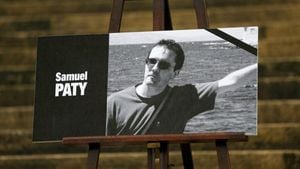A chilling narrative has emerged from Pittsburgh, Pennsylvania, where authorities are dealing with a shocking case involving two individuals charged with vandalizing local Jewish centers. This case is particularly troubling due to the self-identification of one suspect as a ‘Hamas operative’ and their alarming intentions surrounding violence.
Mohamad Hamad, 23, and Talya A. Lubit, 24, stand accused of targeting various Jewish community locations, including the Chabad of Squirrel Hill and the Jewish Federation of Greater Pittsburgh. These venues are located within the vicinity of the Tree of Life synagogue, historically noted as the location of the deadliest antisemitic attack on American soil.
Falling under serious legal scrutiny, Hamad and Lubit have been charged with damaging religious property and conspiracy to commit offenses against the United States. According to court documents, they face potential penalties of up to two years in prison and fines reaching $200,000. It’s not just petty vandalism they’re accused of; investigators have uncovered discussions by Hamad about creating explosives, highlighting the severe threat posed to the local Jewish community.
The timeline for their criminal activities began around October 2023, which coincided disturbingly with violent escalations from Hamas against Israel. The aftermath saw terror and loss of life, reinforcing existing tensions within the community. Court documents reveal Hamad’s participation with devastating intent through graffiti messages like “Jews 4 Palestine,” and “Jewish Federation funds genocide,” sprayed across targeted sites.
Evidence has surfaced detailing not just intent, but also capability. Investigators found messages indicating Hamad’s fixation on martyrdom for Islam, demonstrating his radicalization. The Justice Department reported his alarming actions, including purchasing materials to build explosives—ironically, through suppliers recognized for their potential use by those seeking to harm.
Among the disturbing content revealed, messages between Hamad and Lubit show discussions of planning attacks, with Lubit expressing her anger and frustration at being Jewish, stating, “Every day I think ‘I don’t want to be Jewish anymore’.” These words resonate with the increasing sense of alienation some young people are feeling amid the turbulent political climate.
Lubit also communicated intentions to carry out vandalism against Jewish institutions under the guise of artistic expression, seeking to target non-religious institutions strategically to avoid being labeled as antisemitic directly. According to her messages, the goal was to create confusion about their real motivations.
Law enforcement had been alerted by local Jewish organizations about rising vandalism as early as late July. The Chabad house and the Federation both reported graffiti attacks, prompting investigations. Surveillance footage later linked Hamad to the spray-painting incidents, effectively implicative with evidence of his purchase of the specific colored spray paint used during the attacks.
Authorities were resolute as they condemned the pair's actions. US Attorney Olshan clarified, “Defacing religious property is not protected speech—it is a crime.” He emphasized the importance of ensuring community members can practice their faith without fear, marking this situation as particularly sensitive for the Jewish community already beleaguered by past tragedies.
This case has also ignited discussion about broader trends affecting the political atmosphere surrounding Israel and Palestine, particularly with connections to local governance. Critics have pointed fingers at certain progressive Democrats who are viewed as fostering environments for extremist ideologies to flourish, noting how anti-Israel rhetoric has become intermingled with local politics.
Jeremy Kazzaz, director of the Beacon Coalition, expressed concern over the propagandistic messages filtering through political narratives, warning how such sentiments can embolden individuals like Hamad and Lubit, transforming frustration and alarmist rhetoric directly threatening community safety.
They were clearly not operating alone. Messages displayed links to other extremist groups, underscoring the collaborative nature of such threats. Their claims of fighting for justice conveniently overlooked the meaning of true justice within communities caught up by violence.
This disturbing turn of events also highlights the experiences of Jews as they navigate identity, safety, and the larger narrative of violent extremism on both sides of the geopolitical divide. It prompts serious questions about how community responses, heightened vigilance, and educational outreach can mitigate risks moving forward.
This case, now making its way through the legal system, stresses the need for vigilance and community involvement. Institutions now recognize they must rise to the occasion, fortifying defenses against the potentially harmful ideologies aimed at communities of faith.
All eyes will undoubtedly remain on Pittsburgh as the story develops, signaling it is yet another chapter of struggle against fervent antisemitism witnessed repeatedly but never resolved. The public and officials alike are called to engage with the narratives shaping their neighborhoods—decisions made today could have ramifications for community harmony tomorrow. With complex intersections of religious identity, ideology, and personal motivations being at play, this case widening from one of vandalism to contemplating the societal shifts urges renewed scrutiny on faith-based dialogue.



